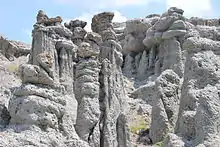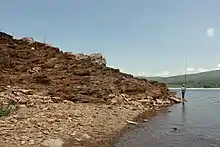Geology of North Macedonia
The geology of North Macedonia includes the study of rocks dating to the Precambrian and a wide array of volcanic, sedimentary and metamorphic rocks formed in the last 541 million years. [1]


Stratigraphy, Tectonics and Geologic History
Precambrian formations include highly metamorphosed crystalline rocks and are distinguished as Pelagonian Horst Anticlinorium (also known as the Pelagon) together with some blocks in the Vardar Zone. They are widely distributed in the Serbian-Macedonian Massif. The lower part of the segment includes gneiss, biotite, muscovite, magmatized and augen gneiss, metagabbro, eclogite, amphibolite, amphibolite shale and micaceous marble. In the upper segment are different types of mica schist, granite, kyanite and staurolite. The upper Precambrian of Pelagon Horst Anticlinorium include mixed series of gneiss, mica schist, barite, cipolem, marble and metarhyolite together with calcite and dolomite up to three kilometers thick. Other parts of the Precambrian complex have widely distributed granitoids which in some cases have merged with surrounding gneiss. There are pegmatite and aplite bodies and veins. Granitoids have been dated as one billion to 800 million years old by potassium-argon dating methods and appear to date to the Grenville orogeny period.
The Precambrian complex in the Serbo-Macedonian Massif is made up of gneiss, mica schist and gabbro amphibolite with small masses of marble and metarhyolite. Gneiss is connected to the lower part of the massif and includes minerals such as muscovite, biotite and augen. Mica schist tends to occur in thin bands while gabbro amphibolites represent the metamorphosed magma intrusions and basic rocks with meta-tuff sometimes interspersed with gneiss and mica schist in bands and lenses. In the Pelagon, rocks have Barrovian-type regional metamorphism up to greenschist grade on the sequence of metamorphic facies. In the Serbo-Macedonian Massif, rocks also reach greenschist facies and exhibit Barrovian-type metamorphism. [2]
Paleozoic (541-251 million years ago)
Paleozoic rocks are widespread in North Macedonia, particularly in the west, including phyllite, volcanic formations and evidence of Riphean through Cambrian, Ordovician, Devonian and Silurian formations based on fossil cephalopods, corals, brachiopods, trilobites and goniatites. Riphean-Cambrian rocks are particularly common in the Serbo-Macedonian Massif, representing sedimentary-volcanic sequences of albite, epidote and chlorite shales, albite-quartz-sericite shales, amphibole metagabbro, and metadiabase, such as the Vlasina Complex in Serbia. Metarhyolites also dominate in the Riphean-Cambrian segment of the Vardar Zone, including phyllite, spilite and keratophyre, epidote-chlorite, spilite-mica schist and low-grade metamorphic shales. Ordovician rocks are represented by metasediments such as phyllite, sandy phyllite, quartzite sandstone and some shales. The Silurian also has phyllite-like rocks but has a greater proportion of volcanic and quartz porphyry rocks. The Devonian is western North Macedonia is also defined by phyllites, together with graphite shale, conglomerate, quartzite and carbonaceous shales, along with marble containing crinoid fossils. Paleozoic formations in different zones indicate that the lower units are most complex in eastern North Macedonia, while the Ordovician and Devonian formations tend to be less numerous in the Vardar Zone and are generally more present in the west. The Kraistides, a volcanic complex spanning into neighboring Bulgaria dominates some parts of the country, with greenschist, metadiabase and spilite in its lower levels, and phyllite schists in its upper levels.
Paleozoic magma formations include granitoid intrusions in both the west and the east, such as the Pelister Massif, in the west, which is well known to geologists because it breaks through Caledonian orogeny age Paleozoic formations, forming 456 million years ago. It includes biotite, alkali granites and adamellite. The Kruschevo granodiorite is associated with the Hercynian orogeny 289 million years ago representing biotite granite that was impacted by intense metamorphism. The granite here tends to be cataclastic while biotite has largely been transformed into secondary minerals. The Kraistide area in the east has some additional intrusions, including laminated granites and rose-colored granites, together with aplite and quartz porphyry.
Regional metamorphism of Paleozoic rocks in western North Macedonia is characterized by low temperatures and high pressures, particularly Paleozoic rocks during the Alpine orogeny period went through a single period of intense cataclastic metamorphism. [3]
Mesozoic (251-66 million years ago)
Triassic rocks are mostly found in western North Macedonia, although less in the Vardar Zone, covering only a small area in the Delchevo border zone near Bulgaria. They are mainly volcanic rocks in the lower units overlain by carbonaceous dolomite. Jurassic rocks are particularly common in the Vardar Zone, particularly in the west. In this area, rocks are extremely varied due to ophiolite formations and massifs. The ophiolites are found in serpentinized ultra-mafic masses or sometimes as more complete ophiolite complexes. Apart from ultrabasic rocks, there is also diabase, gabbro, peridotite and basalt. In the Vardar Zone, a series of faults and diapirs are laminated and highly serpentinized. The Radusha Massif is the most significant ophiolite massif, covering an area of 60 square kilometers northwest of Skopje. Chromium ore was extracted from the massif for decades and it also hosts dunite, harzburgite, veins and lenses of gabbro and rodingite. Gabbro-diorites of the ophiolite suite include the Demir Kapija-Gevgelija, Klepa and Skopska Crna Gora massifs in the central part of the Vardar Zone. The Demir Kapija-Gevgelija Massif extends over an area of 400 square kilometers.
Basal conglomerate in the Demir Kapija area are overlain by massive limestones from the Tithonian. Ophiolite-gabbro cumulates are identified as oceanic-type gabbros and basalts are believed to have formed from up to 20 percent pre-existing crustal rock. Among the acidic magmatic intrusive bodies in the area are granites and granodiorites. In the west, in the vicinity of Korab Mountain, is a limestone formation with layers of chert and a flysch formation dominating the sub-soil, made up of claystone, limestone and siltstone. Toward the south is an additional ophiolite complex with similar rocks to the Vardar Zone.
Cretaceous rocks include examples from the Turonian and Senonian. Albian rocks are only found around the southeastern city of Shtip. Flysch is the most common remnant of the Senonian, particularly in the western Vardar Zone (up to three kilometers of alternating conglomerates, sandstones, arkose, marl, limestone and rudist fossils—shifting more toward siltstone in the east). Along the Radika River and Drim River in western North Macedonia, flysch, a carbonaceous sandbar limestone and olistolith limestone blocks outcrop. Cretaceous intrusive bodies include small granite bodies along the Pelagon fault zone, dating to 118 million years ago. [4]
Cenozoic (66 million years ago-present)
The Cenozoic is represented by Eocene continental and marine deposits, along with volcanic formations from the Neogene and the last 2.5 million years of the Quaternary. Eocene rocks are mainly found in the Vardar Zone, especially close to Delchevo along the Bulgarian border and Debar. Red or violet conglomerate and sandstone make up the lower layers along with molasse formations. They are overlain by alternating sequences of sand and clay flysch with limestone layers rich in Eocene fossils. The Oligocene along the Bulgarian border has quartz latite and dacite rocks. Continental molasse deposited during the Miocene and Pliocene with sand, clay, tuff, volcanic ash, although there are some layers of diatomaceous earth and limestone in the Pelagon area. Marl, 1.5 kilometers thick fills the Skopje valley. Pliocene sands are covered by limestone and travertine which resulted from lake beds and hydrothermal waters. The Zletovo-Kratovo volcanic formation is also from the same period. Small basalt eruptions at the edge of the Vardar Zone in the early Quaternary produced some of the youngest rocks in the country. [5]
Natural resource geology
In the past, iron, chromium, diatomite, marble, perlite and other resources have been mined in North Macedonia. Lead, zinc, copper, decorative stone and quartzite were mined on a small scale in the 1990s.
See also
References
| Wikimedia Commons has media related to Geology of the Republic of Macedonia. |
- Moores, E.M.; Fairbridge, Rhodes W. (1997). Encyclopedia of European & Asian Regional Geology. Springer. p. 517-523.
- Moores, E.M.; Fairbridge, Rhodes W. 1997, p. 519.
- Moores, E.M.; Fairbridge, Rhodes W. 1997, p. 520-521.
- Moores, E.M.; Fairbridge, Rhodes W. 1997, p. 521-522.
- Moores, E.M.; Fairbridge, Rhodes W. 1997, p. 522-523.
